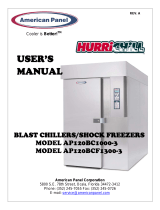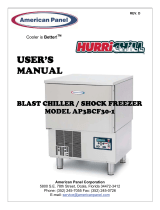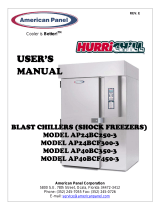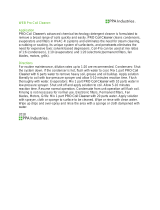Henny Penny BCM-110 is a blast chiller/freezer designed to rapidly cool or freeze large quantities of food, preserving its quality and safety. It features two modes: Chilling and Freezing, allowing you to chill food down to 39°F (4°C) or freeze it to 0°F (-18°C) within a few hours. The unit also includes a De-icing function to remove ice buildup and maintain optimal performance. Its digital display and intuitive controls make it user-friendly, while its durable construction ensures longevity.
Henny Penny BCM-110 is a blast chiller/freezer designed to rapidly cool or freeze large quantities of food, preserving its quality and safety. It features two modes: Chilling and Freezing, allowing you to chill food down to 39°F (4°C) or freeze it to 0°F (-18°C) within a few hours. The unit also includes a De-icing function to remove ice buildup and maintain optimal performance. Its digital display and intuitive controls make it user-friendly, while its durable construction ensures longevity.














-
 1
1
-
 2
2
-
 3
3
-
 4
4
-
 5
5
-
 6
6
-
 7
7
-
 8
8
-
 9
9
-
 10
10
-
 11
11
-
 12
12
-
 13
13
-
 14
14
Henny Penny BCM-110 Operating instructions
- Type
- Operating instructions
Henny Penny BCM-110 is a blast chiller/freezer designed to rapidly cool or freeze large quantities of food, preserving its quality and safety. It features two modes: Chilling and Freezing, allowing you to chill food down to 39°F (4°C) or freeze it to 0°F (-18°C) within a few hours. The unit also includes a De-icing function to remove ice buildup and maintain optimal performance. Its digital display and intuitive controls make it user-friendly, while its durable construction ensures longevity.
Ask a question and I''ll find the answer in the document
Finding information in a document is now easier with AI
Related papers
-
Henny Penny BCF-65 Operating instructions
-
Henny Penny BCF-65 User manual
-
Henny Penny BCC-140 Operating instructions
-
Henny Penny BFR/BCR-350 User manual
-
Henny Penny BCF-24 User manual
-
Henny Penny BCF-65 User manual
-
Henny Penny BCF-65 User manual
-
Henny Penny Freezer BCF-110 User manual
-
Henny Penny BCF-110 Installation guide
-
Henny Penny BCM Series User manual
Other documents
-
 American Panel Freezer AP120BC1000-3 User manual
American Panel Freezer AP120BC1000-3 User manual
-
Diamond 18G300500000 Installation, Usage And Maintenance Manual
-
 American Panel HurriChill AP3BCF30-1 User manual
American Panel HurriChill AP3BCF30-1 User manual
-
 American Panel Freezer AP24BC250-3 User manual
American Panel Freezer AP24BC250-3 User manual
-
 Web WCOIL19 Operating instructions
Web WCOIL19 Operating instructions
-
Metos BF161 AG-P Owner's manual
-
Metos BF161 AG Owner's manual
-
Metos BF121 AG Owner's manual
-
Metos BF081 AG Owner's manual
-
Metos BF051 AG Owner's manual

















